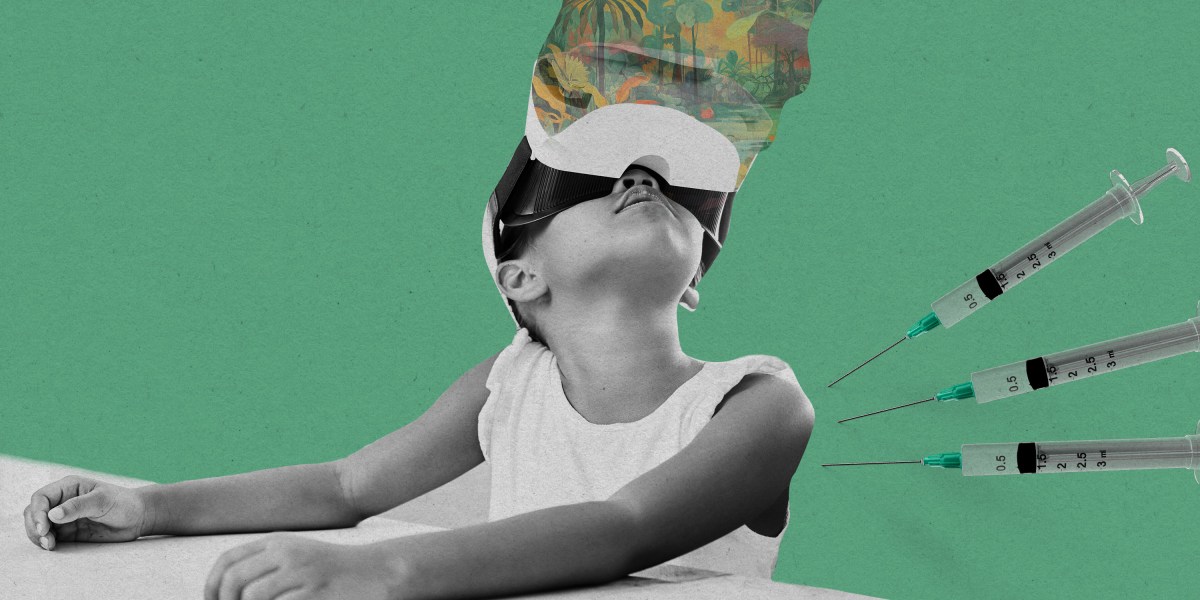The pain is real. The painkillers are virtual reality.

That’s why I was so excited to read about Smileyscope, a VR device for kids that recently received FDA clearance. It helps lessen the pain of a blood draw or IV insertion by sending the user on an underwater adventure that begins with a welcome from an animated character called Poggles the Penguin. Inside this watery deep-sea reality, the cool swipe of an alcohol wipe becomes cool waves washing over the arm. The pinch of the needle becomes a gentle fish nibble.
Studies suggest the device works. In two clinical trials that included more than 200 children aged 4 to 11, the Smileyscope reduced self-reported pain levels by up to 60% and anxiety levelsby up to 40%.
But how Smileyscope works is not entirely clear. It’s more complex than just distraction. Back in the 1960s, Ronald Melzack and Patrick Wall posited that pain signals travel through a series of “gates” in the spinal cord that allow some to reach the brain and keep others out. When the brain is occupied by other stimuli, the gates close and fewer pain signals can get through. “And that’s the mechanism of action for virtual reality,” says Paul Leong, chief medical officer and co-founder of Smileyscope.
Not all stimuli are equally effective. “[In] traditional virtual reality you put on the headset and you go somewhere like a beach,” Leong says. But that kind of immersive experience has nothing to do with what’s happening in the real world. Smileyscope aims to reframe the stimuli in a positive light. Mood and anxiety can also affect how we process pain. Poggles the Penguin takes kids on a thorough walk-through of a procedure before it begins, which might reduce anxiety. And experiencing an underwater adventure with “surprise visitors” is undoubtedly more of a mood-booster than staring at clinic walls, waiting for a needle prick.
“There are a lot of ways to distract people,” says Beth Darnall, a psychologist and director of the Stanford Pain Relief Innovations Lab. But the way Smileyscope goes about it, she says, is “really powerful.”
Researchers have been working on similar technologies for years. Hunter Hoffman and David Patterson at the University of Washington developed a VR game called SnowWorld over two decades ago to help people with severe burns tolerate wound dressing changes and other painful procedures. “We created a world that was the antithesis of fire,” Hoffman told NPR in 2012, “a cool place, snowmen, pleasant images, just about everything to keep them from thinking about fire.” Other groups are exploring VR for postoperative pain, childbirth, pain associated with dental procedures, and more.
Companies are also working on virtual reality devices that will address a much tougher problem: chronic pain. In 2021 RelieVRx became the first VR therapy authorized by the FDA for pain. (The FDA keeps a list of all authorized VR/AR devices.) The tool aims to teach people how to manage chronic pain, which is entirely different from the temporary sting of a needle stick. “It’s vastly more complex on every level,” says Darnall, who helped develop RelieVRx and now serves as chief science advisor for AppliedVR, which markets the device.
Chronic pain is long term, and often life altering. “You have now literal changes in your nervous system as a consequence of experiencing pain long term,” Darnall says. “You have stored tension, you have maybe persistent anxiety, your activity levels have changed, you have sleep problems.” The alarm bell rings long after the danger has passed, for months, years, or even decades.





